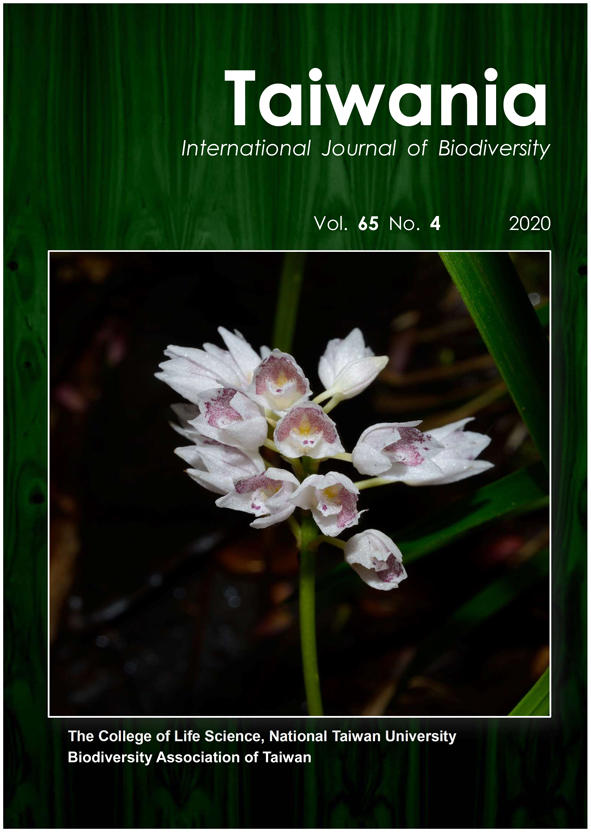Research Paper
Taxonomic distinction of Calamus nambariensis Becc., in Northeast India based on morphological and molecular markers
Kishor Deka, Sashin Kumar Borthakur, Bhaben Tanti
Published on: 04 November 2020
Page: 529 - 540
DOI: 10.6165/tai.2020.65.529
Abstract
Calamus nambariensis Becc. is a high quality of rattan, threatened to the Northeastern region of India. The species was first described by O. Beccari based on a fragmentary specimen collected by G. Mann from Nambor Wildlife Sanctuary of Assam, India. In this study, an extensive survey was carried out to locate the occurrence of C. nambariensis in the Northeastern part of India and to determine their diversity and discrimination through morphological and molecular markers. Specimens collected from six localities; Nambor Wildlife Sanctuary (WLS), Hoollongapar Gibbon Sanctuary, Dehing Patkai WLS of Assam and Kimin, Khonsa and Namdapha National Park of Arunachal Pradesh showed considerable morphological variations among themselves. These differences are accommodated by assigning the status of subspecies as Calamus nambariensis subsp. nambariensis and Calamus nambariensis subsp. arunachalensis, and varieties such as Calamus nambariensis subsp. nambariensis var. nambariensis and Calamus nambariensis subsp. nambariensis var. hoollongapariensis. The taxonomic delimitation is also endorsed by matK, trnL-CD, and trnL-EF sequence analysis which strengthened our findings. The variations observed among the C. nambariensis occurring in northeastern India based on morphological and genetic diversity might be due to their adaptation in different biogeoclimatic conditions over the time.
Keyword: Arecaceae, morphological diversity, genetic diversity, phylogenetic analysis, matK, trnL-CD, trnL-EF
Literature Cited
Altschul, S.F., W. Gish, W. Miller, E.W. Myers and D.J. Lipman. 1990. Basic local alignment search tool. J. Mol. Bio. 215(3): 403–410.
DOI: 10.1016/S0022-2836(05)80360-2View Article
Google Scholar
Asmussen, C.B., J. Dransfield, V. Deickmann, A.S. Barfod, J.C. Pintaud and W.J. Baker. 2006. A new subfamily classification of the palm family (Arecaceae): evidence from plastid DNA phylogeny. Bot. J. Linn. Soc. 151(1): 15–38.
DOI: 10.1111/j.1095-8339.2006.00521.xView Article
Google Scholar
Basu, S.K. 1992. Rattans (Canes) in India-A Monographic Revision. Rattan information Centre, Kepong, Kuala Lumpur.
Baker, W.J., C.B. Asmussen, S.C. Barrow, F.J. Drans and T.A. Hedderson. 1999. A phylogenetic study of the palm family (Palmae) based on chloroplast DNA sequences from the trnL-trnF region. Plant Syst. Evol. 219(1-2):111–126.
DOI: 10.1007/BF01090303View Article
Google Scholar
Baruah, P.S., K. Deka, B. Sarma, P. Das, S.K. Borthakur, and B. Tanti. 2017. Assessment of few unexplored RET plant wealth of Assam, India. J. Advanced Plant Sci. 9(2):10–15.
Beccari, O. 1908. Asiatic palms - Lepidocaryeae. Part I. The species of Calamus. Ann. Roy. Bot. Gard. (Calcutta) 11:1–518.
Beccari, O. 1913. Asiatic palms - Lepidocaryeae. The species of Calamus. Supplement to Part I. Ann. Roy. Bot. Gard. (Calcutta) 11: 1–142.
Beccari, O. 1914. Asiatic palms - Lepidocaryeae. The species of Calamus. Supplement to Part I. Ann. Roy. Bot. Gard. (Calcutta) 11:1–83.
Chowdhury, U., B. Tanti, P. Rethy and P.R. Gajurel. 2014. Analysis of genetic diversity of certain species of piper using RAPD-based molecular markers. Appl. Biochem. Biotechnol. 174(1):168–173.
DOI: 10.1007/s12010-014-1053-5View Article
Google Scholar
Deka, K., S.K. Borthakur and B. Tanti. 2017. Distribution and population dynamics of Calamus nambariensis Becc.–An endemic and threatened cane of Assam. Ann. Plant Sci. 6(12):1829–1834.
DOI: 10.21746/aps.2017.6.12.5View Article
Google Scholar
Deka, K., S.K. Borthakur and B. Tanti. 2018a. Lectotypification of Calamus nambariensis (Arecaceae). Nord. J. Bot. 36(10): e01953.
DOI: 10.1111/njb.01953View Article
Google Scholar
Deka, K., S.K. Borthakur and B. Tanti. 2018b. Habitat mapping, population size and preventing extinction through improving the conservation status of Calamus nambariensis Becc.-an endemic and threatened cane of Assam, India. Acta Ecol. Sin. 38(6): 412–421
DOI: 10.1016/j.chnaes.2018.03.005View Article
Google Scholar
Doyle, J.J. and J.L. Doyle. 1987. A rapid DNA isolation procedure for small quantities of fresh leaf tissue. Phytochemical Bull. 19:11–15.
Dransfield, J. 1981. The biology of Asiatic rattans in relation to the rattan trade and conservation. In: Synge H (eds), The Biological Aspects of Rare Plant Conservation, John Wiley & Sons Ltd., London, pp. 179–186.
Dransfield, J., N.W. Uhl, C.B. Asmussen, W.J. Baker, M.M. Harley and C.E. Lewis. 2008. Genera Palmarum - the evolution and classification of palms. Royal Botanic Gardens, Kew, Richmond, pp.732.
Evans, T.D., K. Sengdala, O.V. Viengkham and B. Thammavong. 2001. Afield Guide to the Rattans of LAO PDR. Royal Botanic Gardens. Kew, pp. 66 – 67.
Felsenstein, J. 1983. Parsimony in systematics: biological and statistical issues. Ann. Rev. Eco. Evol. Sys. 14(1): 313–333.
DOI: 10.1146/annurev.es.14.110183.001525View Article
Google Scholar
Felsenstein, J. 1985. Confidence limits on phylogenies: An approach using the bootstrap. Evolution 39(4):783–791.
DOI: 10.2307/2408678View Article
Google Scholar
Haridasan, K., A. Sarmah, S.N. Hegde and L.R. Bhuyan. 2002. Field Manual for propagation and Plantation of Canes in Arunachal Pradesh. SFRI information Bulletin No. 15. pp.1–17
Jain, S.K. and R.R. Rao. 1977. A Handbook of Field and Herbarium Methods. Today & Tomorrow’s Printers and Publishers. New Delhi. India.
Kimura, M. 1980. A simple method for estimating evolutionary rate of base substitutions through comparative studies of nucleotide sequences. J. Mol. Evol. 16(2):111–120.
DOI: 10.1007/BF01731581View Article
Google Scholar
Kumar, S., G. Stecher and K. Tamura. 2016. MEGA7: Molecular Evolutionary Genetics Analysis version 7.0 for bigger datasets. Mol. Bio. Evol. 33(7):1870–1874.
DOI: 10.1093/molbev/msw054View Article
Google Scholar
Nei, M. and S. Kumar. 2000. Molecular Evolution and Phylogenetics. Oxford University Press, New York.
Rahman, A., B. Tanti, G.C. Sarma and J. Kalita. 2012. Genetic diversity of Perseabombycina from Goalpara district of Assam, India. Adv. Biosci. Biotechnol. 3(1): 20–24.
DOI: 10.4236/abb.2012.31004View Article
Google Scholar
Rama Bhat, P., S.P.H. Shenoy and K.M. Kaveriappa. 2010. Status of some species of rattans in the forests of the Western Ghats of Karnataka, India. Afr. J. Plant Sci. 4: 455–463.
Renuka, C. 1999. Indian rattan distribution-An update. Indian Forester 125: 591–598.
Renuka, C. and V. Sreekumar. 2012. A field guide to the palms of India. Kerala Forest Research Institute, Peechi, Kerala, India, 256 pp.
Rzhetsky, A and M. Nei. 1992. A simple method for estimating and testing minimum evolution trees. Mol. Biol. Evol. 9(5): 945–967.
DOI: 10.1093/oxfordjournals.molbev.a040771View Article
Google Scholar
Saitou, N. and M. Nei. 1987. The neighbor-joining method: A new method for reconstructing phylogenetic trees. Mol. Bio. Evol. 4(4): 406–425.
DOI: 10.1093/oxfordjournals.molbev.a040454View Article
Google Scholar
Sreekumar, V.B. and A. Henderson. 2014. Nomenclatural notes on Indian Calamus (Arecaceae). Phytotaxa 166(2):145–149.
DOI: 10.11646/phytotaxa.166.2.6View Article
Google Scholar
Thomas, S. and K. Haridasan 1997. Calamus nambariensis Becc. - an interesting rattan palm from Arunachal Pradesh. Arunachal forest news 15: 29–30.
Thompson, J.D. and T.J. Gibson. 1994. Improving the sensitivity of progressive multiple sequence alignment through sequence weighting, position-specific gap penalties and weight matrix choice. Nucleic Acids Res. 22(22): 4673–4680.
DOI: 10.1093/nar/22.22.4673View Article
Google Scholar
Uma Shaanker, R., K.N. Ganeshaiah, K.V. Srinivasan, R. Rao and L.T. Hong. 2004. Bamboo and Rattans of the Western Ghats: Population biology, Socio-economic and Conservation Strategies. ATREE, UAS, IPGRI, Bangalore.
Weidelt, H.J. 1990. Rattan growing in South-East Asia- an ecological well-adapted form of land use. Plant Research and Development 31:26–32.


